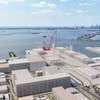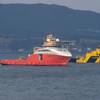Early results of a pilot to test 100 percent scanning of U.S.-bound containerized cargo shows both promise and challenges, a top Department of Homeland Security official told lawmakers recently.
Stewart Baker, assistant secretary of Homeland Security for policy, indicated there were many challenges to the goal of 100 percent scanning in every port but that the department will pursue that goal aggressively.
The Sept. 11 commission recommendation law mandates the scanning of all U.S.-bound cargo containers at foreign ports by July 2012. The law gives the Homeland Security secretary leeway if he finds the available integrated scanning technology, which includes a combination of imaging — such as X-ray — and radiation detection, is not adequate. The secretary would be permitted to seek extensions of the mandate every two years.
A 2006 port security law requires three foreign ports to pilot test scanning 100 percent of U.S.-bound containers using integrated scanning. The law requires the pilots reach “full-scale implementation” and the DHS announced it has met that goal at ports in Southampton, U.K., Port Qasim, Pakistan, and Puerto Cortez, Honduras, under its Secure Freight Initiative.
The 2006 law requires a report on the pilot in April 2008, but lawmakers at a hearing of the Senate Homeland Security and Governmental Affairs Committee on Tuesday had preliminary questions. Asked by Norm Coleman, R-Minn., if the pilot program has slowed trade, Baker indicated that it had not been slowed but that weather conditions had, at times, created some challenges for equipment. Some shippers prefer to use the pilot ports to reduce the likelihood of cargo inspections in the United States, while others want to avoid the ports because of increased fees, Baker said.
Among challenges in the pilot, installing equipment has required reconfiguring ports’ layouts, which vary greatly, and even the concrete used at each port can create difficulties if it emits natural radiation that throws off sensors, Baker said. Other complications include figuring out how to scan trans-shipments, in which a container is transferred by crane directly from one ship to another. Each country requires diplomatic agreements and their information technology infrastructure can make transferring the scanning data to U.S. officials in real time very high cost.
The ports in the United Kingdom and Pakistan participating in the pilot are both managed by the United Arab Emirates-owned port terminal operator DP World, whose plan to take over operations at six U.S. ports was strongly criticized in February 2006 by members of Congress, who saw the deal as a threat to national security. In response, DP World sold its operations at those U.S. ports.
DHS also intends to go beyond the 2006 port security law requirements and conduct scanning pilots at four additional foreign ports.
The Sept. 11 commission recommendation law would allow the Homeland Security secretary to seek extensions every two years on the July 2012 mandate for 100 percent screening if he found that certain conditions existed. Such conditions include: the scanning would “significantly impact trade;” the necessary scanning equipment was not available; the equipment had too high a false alarm rate; the equipment could not be integrated as necessary with existing systems; the equipment did not have an adequate automatic notification of when cargo required further inspection; and the equipment could not be installed in foreign ports because the port does not have the physical characteristics to install such a system. [Source: CQ Homeland Security]
Subscribe for
Maritime Reporter E-News
Maritime Reporter E-News is the maritime industry's largest circulation and most authoritative ENews Service, delivered to your Email five times per week










